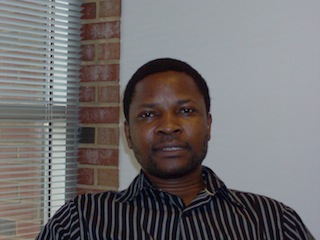 UAB’s first K-RITH student, James Hove Mazorodze, is following in some big footsteps along the path to research on TB and HIV. He is working on his Ph.D. thesis at the KwaZulu-Natal Research Institute for Tuberculosis and HIV (K-RITH) in Durban, South Africa, under the supervision of Dr. Andries Steyn, who maintains labs at K-RITH and at UAB. He will work one year in Dr. Steyn’s lab here at UAB before returning to South Africa.
UAB’s first K-RITH student, James Hove Mazorodze, is following in some big footsteps along the path to research on TB and HIV. He is working on his Ph.D. thesis at the KwaZulu-Natal Research Institute for Tuberculosis and HIV (K-RITH) in Durban, South Africa, under the supervision of Dr. Andries Steyn, who maintains labs at K-RITH and at UAB. He will work one year in Dr. Steyn’s lab here at UAB before returning to South Africa. As a young boy growing up in Zimbabwe, Mazorodze enjoyed reading stories about American scientists and their work. He was particularly interested in stories about research on HIV and TB, two infectious diseases that threaten the population of his country. One of the scientists he read about was UAB alumnus Bill Jacobs, Ph.D., one of the founders of KRITH, who studies tuberculosis and other diseases in the Mycobacteriaceae family at the Albert Einstein College of Medicine in New York.
Mazorodze continued his interest in science research throughout high school, and he went on to earn a bachelor’s degree in biochemistry from the University of Zimbabwe. After working for a year in a plant biotechnology lab in South Africa, he turned his focus to TB research. “I applied for and received a Fogarty Fellowship to study Mycobacterium tuberculosis (Mtb) pathogenesis,” says Mazorodze. “This fellowship allowed me to travel to New York and work with Dr. Bill Jacobs, the researcher I had read about for several years.”
While in Jacobs’ lab at Einstein, Mazorodze worked with the team of researchers who focused on understanding the role of genes that are possible drug targets as well as vaccine candidates in Mtb. “We worked on the broad aspects of high-throughput, high-level expression systems to express Mtb genes in M. smegmatis. During my visit we cloned, expressed and purified glgE and over 140 putative immunodorminant genes of Mtb in M. smegmatis. By overexpressing these genes, we wanted to study their immunemodulating roles during host-pathogen interaction, which had been reported previously in literature. We also did functional and validation studies on GlgE, previously reported in Dr. Jacobs’ lab as a drug target in Mtb. I also learned to manipulate temperature sensitive mycobacteriophages in the delivery of foreign DNA in Mtb.”
It was in Jacobs’ lab that Mazorodze first learned about UAB. Jacobs, who was inducted into the National Academy of Sciences earlier this year, did his doctoral dissertation studying leprosy in the Microbiology Department at UAB. “Working with Dr. Jacobs is one of the cherished moments in my life, both in and outside the lab. My association with him has opened so many other opportunities in my career. He still shows pictures of himself as a graduate student here,working on leprosy in armadillos. And, now, here I am studying at UAB,” says Mazorodze.
Although Mazorodze is just beginning his Ph.D. program, he is well on track for joining Dr. Jacobs and Dr. Steyn in the study of drug-resistant forms of TB. Along the way, he is sure to inspire other young scientists and maybe even one day show pictures of himself in the Microbiology Department at UAB.
KwaZulu-Natal Research Institute for Tuberculosis and HIV (K-RITH), in Durbin, South Africa, is an independent, state-of-the-arts research institute that works in collaboration with academic and clinical institutions in South Africa and around the world to develop effective ways to diagnose and treat TB and HIV. Their programs include Masters, Pre-Doctoral, and Ph.D. opportunities. UAB microbiologist Dr. Andries Steyn was the first scientist recruited to work at K-RITH.
-er-